If you want to know How to Save a Dying Jade Plant, go through these Crassula Ovata Problems and Solutions and keep it happy and growing.
Maintaining Crassula ovata can be super easy when you know all about its issues. Here’s a detailed guide on How to Save a Dying Jade Plant.
Crassula Ovata Problems and Solutions
1. Yellow or Brown Soft Leaves

Problem: Yellow, brown, or translucent (watery) foliage with a soft and droopy appearance and brown spots.
Causes: Overwatering, slow-draining soil, and lack of drainage holes in the container. The leaves become mushy and yellow because of excess moisture that can cause root rot and kill the plant.
Solution
Jade plants are native to arid areas with sporadic rainfall and well-draining sandy soil that does not hold too much moisture.
- You can prevent such issues by imitating the jade plant’s native conditions.
- Use well-draining loamy soil and allow it to dry out well between watering spells.
- Make sure the pot has drainage holes.
- Cut off the watering in the rainy and winter months as the growth rate diminishes.
2. Shriveled, Dry, and Dropping Foliage
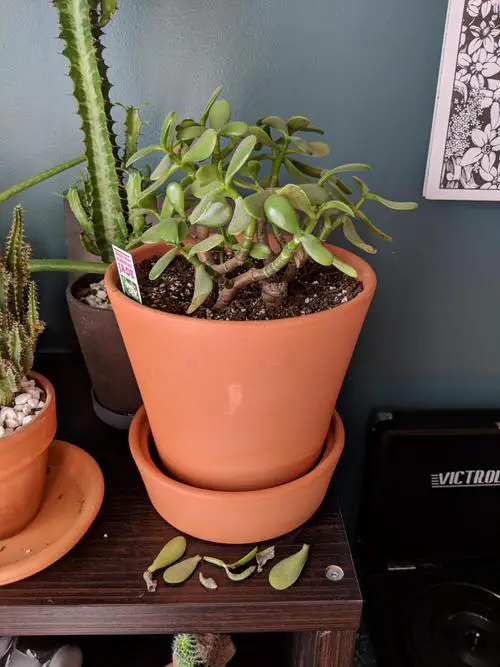
Problem: Foliage getting wrinkled, crisp, brown, and finally dropping from the plant.
Causes: It happens due to drought stress from under-watering when moisture does not reach the roots. It might also happen if the plant is located too close to heating vents or kept in a hot place.
Solution
- A drought-stressed jade plant can be saved easily. Just water the plant completely till the soil is hydrated, soaked, and water seeps out from the container’s drainage holes. If you want to grow jade plant in a pot with no drainage holes, have a look at this article.
- Always water thoroughly.
- Make sure to use a well-draining and porous growing medium.
Note: The plant loses lower foliage, which is a natural process. Also, old foliage at the bottom dies as plants mature and produce new foliage.
3. Black Leaves
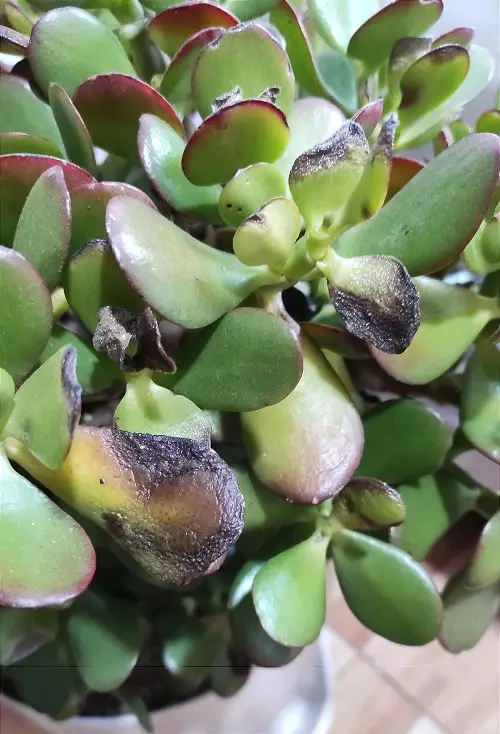
Problem: Leaves at the top and bottom are getting a dark brown or black hue.
Causes: This generally happens due to overwatering. An overly wet growing medium and lack of sunlight are deadly for a jade plant. Another reason for this is crushed and damaged leaves when transferring the plant through a courier or putting weight on the foliage.
Solution
Cut back the watering, remove the damaged leaves, and ensure the plant gets filtered light daily.
4. Leggy and Stretched Plant
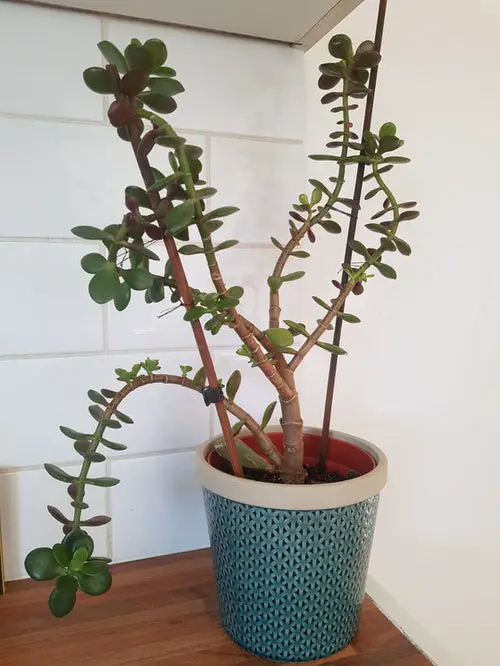
Problem: Stems, leaves, or entire plants getting droopy, misshapen, and growing waywardly.
Causes: The droopy leaves are the result of low light levels or overwatering that causes root rot, which makes branches, stems, and leaves leggy. Due to low light, the plant grows lanky and elongated in search of more sun, the leaves will be thin, less colorful, and robust.
Solution
- Avoid overwatering at all costs. Water only when the topsoil feels dry to touch or develops minor cracks.
- Grow the plant in the bright portion of your home, where it receives indirect light with some direct sun in the morning. An area that receives bright indirect light all day long is the best place.
5. Stunted Growth
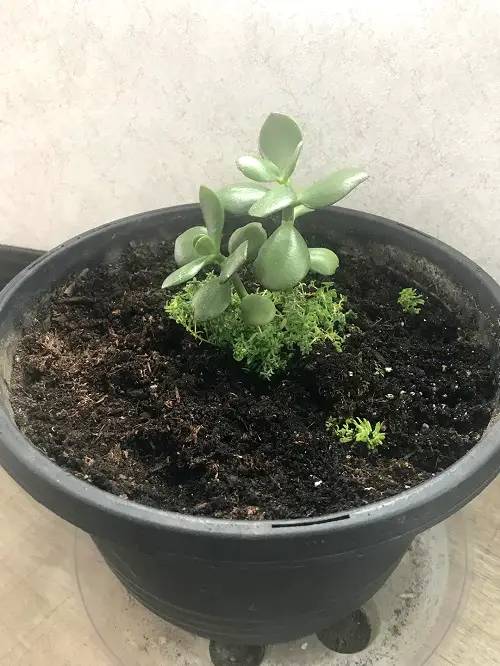
Problem: Plant growing slowly or not growing at all. The size remains the same for weeks or even months.
Causes: First of all, it’s a slow-growing plant, and on top of that, the growth slows down in the winter months in response to decreased levels of natural light and cool temperatures. However, it returns to normal growth in spring and summer.
Another reason will be if the jade is planted in a substantially larger pot than the root ball. Similarly, other things that affect its growth are low light, extremely poor soil and old growing medium.
Solution
- Try to grow the plant in a warm temperature range, at least above 50 F (10 C). Make sure it gets plenty of bright light. Also, move it to a warmer area of the house.
- Plant your jade in a moderately proportional pot to the size of the root ball.
6. Wilted and Shriveled Foliage
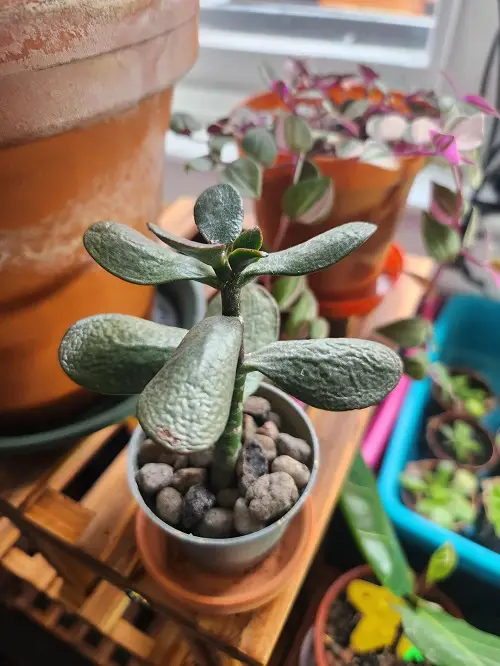
Problem: Wilting, mushy, limp, or shriveled leaves that are soft to the touch.
Causes: There are several reasons behind such issues, such as overwatering, insufficient sunlight, underwatering, freezing temperatures, or overfeeding.
If the leaves are soft and mushy, it’s due to oversaturation. Conversely, if they are wrinkled and shriveled, it’s due to underwatering.
Solution
- Follow a proper watering schedule and allow the soil to dry out before watering again.
- Grow the plant in an area where it gets bright indirect light. Do not expose the plant to direct sun without acclimatizing it.
- Protect your jade plant from freezing temperatures by placing it in a warm area.
- Do not overfeed your jade; stop fertilizing it from mid-fall to winter if you live in a cold climate. Read more here.
7. Sunburn

Problem: Burnt foliage becomes crisp brown or black in color and looks like blemishes on the spotless leaves.
Causes: Too much sun exposure.
Solution
Avoid keeping the plant in the intense afternoon sun for long hours. It would be best to pick a spot that gets bright and indirect light all day long. An east or north-facing windowsill would provide optimal sunlight.
8. Hard Water Spots
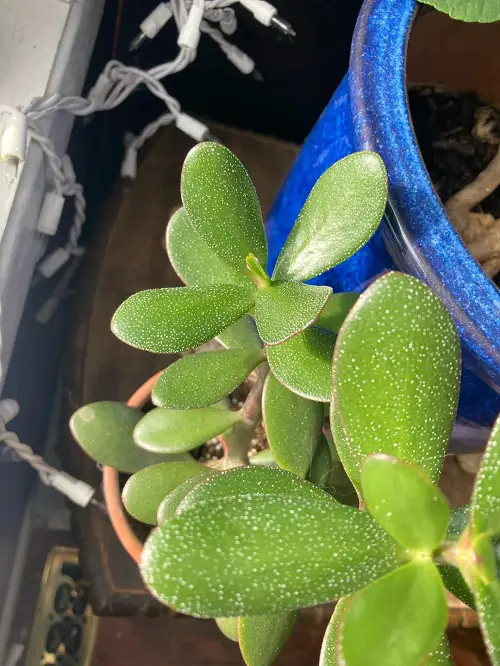
Problem: White spots on a few leaves or the entire plant.
Causes: Using calcium-rich underground water or tap water with excess minerals.
Solution
- If you are using tap water, let it sit overnight to let the minerals settle down. You can also use the river, well, or RO water.
- Avoid wetting the leaves while watering the plant. Gently pour water around the base while ensuring it doesn’t make the soil spill out of the pot, as this will not only increase the chances of fungal growth but also leave nasty stains.
9. Overfertilization

Problem: Yellow and brown edges on the foliage.
Causes: Using too much fertilizer frequently or keeping the plant in extreme sun.
Solution
- If you have used a good quality potting mix, then feeding the plant once in 4-8 weeks with a balanced fertilizer, diluted to half or one-quarter of its strength, would be just fine.
- You can also top-dress the soil with well-rotted manure or compost.
10. Pest Problems

Problems:
- Honeydew-like sticky substance on the leaves and stems indicates Aphid activity on the Jade plant.
- Mealybugs make white patches of cotton-like substance on the stem joints and leaves.
- Spider mites result in chlorotic patches on the leaves.
Causes: Mealybugs, Spider mites, and Aphids
Solution
Avoid using strong insecticidal soap as it might damage the plant. Use a strong jet of water to deter them away. If the problem persists, swab the affected leaves with a cotton dipped in rubbing alcohol.
How to Save a Jade Plant Dying Due to Over-Watering
Symptoms
Jade plants do not like waterlogged soil, which is the most common reason killing them. Signs of an overwatered jade plant include weak foliage that can drop with a slight touch and mushy and translucent leaves.
This excessive watering finally leads to root rot, and the plant displays symptoms like yellow leaves, easily breakable stems, and dropping foliage. Roots develop brown/black gloppy slime, which must be washed away immediately.
Solution
To save an overwatered jade plant, it needs to be dried early without any delay. You can also read our guide on how to save an overwatered succulent for more information.
- Take the plant out of the pot and allow the roots to dry.
- Snip away dead and rotten roots.
- Re-pot it in a fresh and dry potting mix, and do not water the plant for some days. This will give enough time for the roots to dry and recover.
- Keep the plant in bright indirect light and slowly acclimate it to direct sunlight.
- Next, water only when the topsoil is dry.
- If the plant is beyond recovery–remove the surviving healthy leaves or stem cuttings and allow the cut ends to heal for 2-4 days until they form callus. Plant them by following the instructions here!
Some Quick Tips
- Use a succulent or cactus mix to grow this plant.
- Water the plant less frequently but thoroughly.
- Adding pebbles on top of the soil for decoration will trap the moisture, restricting the air circulation, which eventually makes the plant suffer from excess moisture, leading to root rot. So, avoid adding pebbles or any other decorative items over the topsoil–if you don’t have a green thumb.
- Remove the dead and damaged leaves from time to time.
- Cut the long, leggy, and heavy branches or provide support.
- You can also use unconventional methods like yogurt, burying pennies and others to save your plant.
- Keep an eye on the common jade plant problems and symptoms listed above to save your jade plant from dying.



My jade tree is having many of these problems. Now I know how to solve them. Thanks!